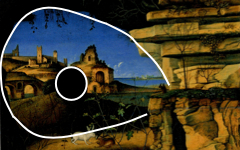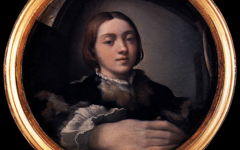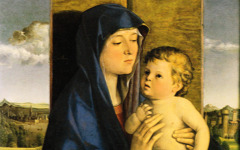Bellini’s Pesaro Altarpiece (c. 1471/4)
A magnificent altarpiece by Giovanni Bellini is partly conserved in Pesaro, Italy where you can see its central panel, The Coronation of the Virgin (below). Other panels surrounding it have been dispersed elsewhere. Nevertheless, there should be no doubt that the two largest images in the group, The Coronation and a Pieta now in the Vatican, are paintings about paintings and any subsequent artist looking at either of them would have known that.

Giovanni Bellini, Coronation of the Virgin, the central panel from The Pesaro Altarpiece. (c.1471/4) Museo Civico, Pesaro.
Click image to enlarge.
Who could not notice that the "hollow back" in the giant throne of The Coronation looks odd? It has been made to resemble a framed picture in the same manner that later artists used windows for the same effect. This, then, is not a literal view through a throne; it is a “painting”. (See examples by Manet and Matisse ). The altarpiece was commissioned by the Franciscans, a significant fact because many were mystics who did not trust the senses. Take a look at St. Francis on the far right. He stands to the side like an artist often does, detached from the scene and looking inwards, while holding a quill and tome like an artist might hold a brush and sketchbook – or in their day – an illustrated prayerbook.
Click next thumbnail to continue
A large scene of the Pieta by Bellini once crowned The Coronation and demonstrates with equal certainty that one’s initial understanding of the scene must be mistaken. Joseph of Arimathea behind Christ, a giant Nicodemus and Mary Magdalene attend the dead Christ. Rona Goffen noted that the scene is compressed “to intensify the concentration of the mourners.”1 While true, in that the mourners’ faces are larger than they would otherwise be, that is not the primary purpose. They are compressed because the three attendants are “artists” and the dead Christ pressed against the picture plane is “their painting.”
Click next thumbnail to continue
Here’s why. In the Middle Ages and the Renaissance Nicodemus was believed to have been a sculptor present at the Crucifixion which is why Michelangelo once gave Nicodemus his own self-portrait.2 At the time the professional differentiation between sculptor and painter was less strictly defined. Here Nicodemus as an artist looms over the “painting” of the dead Christ because he is in a different reality. Christ is just “a painting”; Nicodemus is real….though Bellini as a mystic would have thought of it the other way round. Life in Christ was the true reality; ours in this world was false.
Click next thumbnail to continue
Mary Magdelene is an “artist” too, pressing her ointment onto the wound of the dead Christ in the same manner as an artist applies pigment to create the dead Christ. The open wound was often thought of in mystic terms as an entry into the body of Christ, one of the reasons it became a cult of adoration among Franciscans. Her left hand is also opened as a painter holds a palette, the thumb separated from the fingers.
Click next thumbnail to continue

Detail of Mary Magdalene from the Pieta compared to a self-portrait of Gentile Bellini
Click image to enlarge.
Some of her features, moreover, seem similar to Gentile Bellini's self-portrait; long hair, similar eyebrows, sloping nose, long nostril, prominent philtrum and small, rounded chin. Magdelene has the feminized features of a Bellini (a famous family of artists) and thus represents the androgynous mind of the true artist.
Click next thumbnail to continue
According to the Gospels, Christ was buried in Joseph of Arimathea’s tomb which is why, in Goffen’s mind, “Joseph seems literally to share his tomb with Christ.”3 Yet there is more. In fusing their two figures together, Bellini indicates the artist’s total identification with Christ, his transformation into Christ.
See below for conclusion
That is the mystic reading which makes this image far more interesting and far more meaningful than the literal. It was not intended for everyone to see and, with the significant exception of artists, it rarely has been.
More Works by Bellini
Notes:
1. Rona Goffen, Giovanni Bellini (Yale University Press) 1989, p.127
2. A 4th century Gospel of Nicodemus became very popular in the late Middle Ages and in one legend Nicodemus carved the crucifix not merely from memory but out of a deep mystical bond with Christ. As a result, the Volto Santo or Holy Face in Lucca, his supposed carving, was a well-known attraction visited by emperors. See Corine Schlief, “Nicodemus and Sculptors: Self-Reflexivity in Works by Adam Kraft and Tilman Riemenschneider”, Art Bulletin 75, Dec. 1993, p.609
3. ibid. p.127
Original Publication Date on EPPH: 16 Feb 2012. | Updated: 0. © Simon Abrahams. Articles on this site are the copyright of Simon Abrahams. To use copyrighted material in print or other media for purposes beyond 'fair use', you must obtain permission from the copyright owner. Websites may link to this page without permission (please do) but may not reproduce the material on their own site without crediting Simon Abrahams and EPPH.







